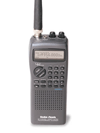|
|
Scanner
Reviews
These pages review different types of scanners and how they are suited to
railscanning. If you want your favorite scanner listed here, write a
review, snap a photo, and send it to me.
 |
Realistic
Pro-29 |
| The
Pro-29. Radio Shack's list price is $249.00. It has
everything a novice or pro railroad scanner needs. 60 channels (you can store up to
60 frequencies in its memories), nice LCD display with good backlight, and
coverage up to 800 MHz (with the usual "Uniden" holes,
including blocked cell phone). It also brags a nice fast scanning
rate. Its easy to use, and pretty rugged too. A second-hand Pro-29
was my second scanner - and I never had
any problems with it. I ended up selling it to help fund my new TrunkTracker, a
decision I regret to this day. The Pro-29 is a Uniden-made scanner. |
|

|
Uniden
Bearcat BC235XLT
Uniden Bearcat BC245XLT |
Even though most
hobbyists purchase the 235 or 245 for following Trunked radio systems (such as Police, fire and
public service radio), the Bearcat line of scanners before and up to the
TrunkTrackers have proven to be excellent conventional scanners. They
reject intermod better than any other scanner I've seen, and have really
good scan speeds. They aren't as flexible as more expensive scanners (The 235
lacks an attenuator, used for filtering interference - the 245 has such a
feature), but are rather easy to
use. The Realistic version of this scanner is the Pro-90. Most Radio Shack
scanners with the 'Realistic' name are made by Uniden, with a few
exceptions. Think of it as the "President's Choice" of
electronics equipment.
The 235 has officially been discontinued by Uniden - so best of luck
finding one new. That's why I
didn't post a 'new' price for it - I couldn't find one! |
 |
Icom
IC-R2 |
The field
performance of the R2 isn't nearly as good as Uniden scanners - the scan speed is
slow and is prone to quite a bit of intermod (specifically on
161.025 MHz), and you can only scan one bank of
frequencies at a time. A real drag.
However, the R2 is tiny compared to the larger Uniden units, and can easily
fit into any camera bag or pocket. The little beast is also rugged - I've
dropped it onto the tracks off of the bridge at Bayview jct. and other than a bit of
a scratch on the back, it was no worse for wear. Unlike most Unidens, the thing runs on
regular batteries - two AA's to be exact (rechargeable cells are a wise investment) As
well, unlike Uniden scanners, Icom radios are full coverage - meaning
absolutely no holes between its 5
KHz and 1.3 GHz coverage. You can listen into some cell phones or the radio between
trains. Nice! Be warned, the R2 isn't for beginners - it takes a bit of work to
memorize how it works (not a lot of buttons on it), so there are a lot of
multiple keypresses to memorize and learn. The R2 is not a railroad scanner by
any means - but its better than nothing! |
 |
Uniden
Sportcat SC180B
Uniden Sportcat SC200 |
In
my opinion, *the* best radio for railroad scanning! A little pricey,
but definitley the best choice. Unidens have always been excellent
at scannig the railroad band, and with *alpha tags* and a blistering
100 channels/sec scan rate, this radio's a clear winner.
The 180B and 200 are pretty much the same radio - except the 200 has
200 channels over the 180B's 100, and the 200's got tone squelch
features. As well, the 180B's yellow and the 200 has blue parts. If
you want a good radio strictly for railroad scanning, then the
180B's my clear choice. |
.
|